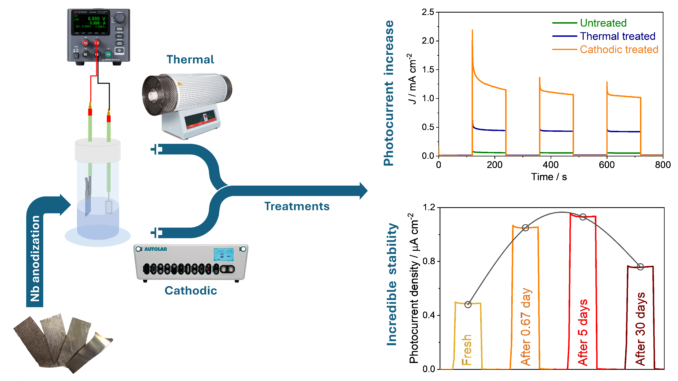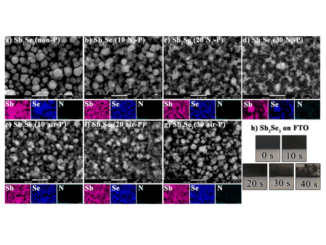
Boosting photocurrent of anodized Nb2O5 by synergetic post-synthesis electrochemical treatment
Abstract: Hydrogen has emerged as a promising alternative to fossil fuels due to its environmental benefits. Niobium pentoxide (Nb2O5) is an effective photocatalyst for water splitting, but its narrow bandgap limits efficiency. However, cathodic polarization doping can be used to shift the bandgap of Nb2O5 to the visible light range, plus tuning its band relative positions, making it a more efficient photocatalyst. This method is simple, inexpensive, and provides precise control over the amount of dopants in the Nb2O5 matrix. This will allow green hydrogen production from a broader range of light sources. To this end, niobium pentoxide was produced by anodizing metallic niobium with subsequent thermal and cathodic treatment of the obtained samples. The resulting electrodes were characterized by their morphology and electrochemical and photoelectrochemical properties. Cathodically treated films were observed to present a much higher photocurrent (about 2.1 times) than those not submitted for any treatment. Besides, it is even more significant than thermally treated ones. Furthermore, the cathodic treatment samples are exceptionally stable, remaining observed for more than 30 days. Therefore, it is concluded that Nb2O5 films can significantly improve their properties by applying simple and quick treatments, making them an even more promising material for application in water electrolysis.
Author(s): Wallas T. Menezes, Roger Gonçalves and Ernesto C. Pereira
Mater. Adv.
Published: 29 May 2024
DOI: https://doi.org/10.1039/D4MA00316K
CDMF
The CDMF, hosted at the Federal University of São Carlos (UFSCar), is one of the Research, Innovation and Dissemination Centers (RIDC) supported by the São Paulo State Research Support Foundation (Fapesp), and also receives investment from the National Council Scientific and Technological Development (CNPq), from the National Institute of Science and Technology of Materials in Nanotechnology (INCTMN).




